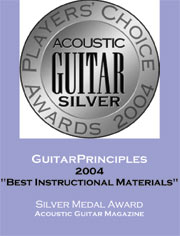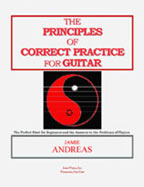Doing bar chords (sometimes spelled "barre") is one of those techniques that many students are never able to do, and many other players, even after learning to do them, do so with varying degress of inefficiency. This is because, even after basic bar chords are learned, students usually remain ignorant of the subtlities of barring, and within those subtlities lies the answer to many of our technical problems. We will take a look at some of those subtilities right now.
The Fingers As Force Directors
In order to penetrate to the deepest levels of understanding regading left hand guitar technique, we must re-define what "fingers" are. We must understand that essentially our fingers are "force directors". That is their job when we play the guitar, to act in such a way as to direct force to the strings. Once we truly appreciate this fact, we will have opened the door to unlimited exploitation of the true potential of our left hand.
As we contemplate this idea, we realize a number of other things. We realize that what we call a "finger" is really a series of four bones, beginning at the wrist. The first bone is in the palm, the second bone begins at the first knuckle, and you figure out the rest! Now, the place where these bones meet we call "joints", and the full expoitation of our joints is one of the goals of left hand development. Our joints should be properly understood to be the "fine tuning knobs" in the process of directing force to the the strings with our fingers. The subtle manipulation of our joints allows us to infinitely vary the amount and direction of force we bring to the strngs. This ability is possesed by all good players, but is one of those "invisible" elements that you cannot really see when you watch a good player Unfortunately, they usually don't know they are doing it, so you are not going to hear about it from them either!.
The Effect of Finger Joints On The Arm and Upper Body
Another realization we have as we examine our left hand technique in light of the understanding that our fingers are force directors, and our joints are the fine tuning knobs of that force is this: the exact way we use our fingers as joints to bring force to the strings directly affects our entire arm and indeed, our entire upper body. This is quite an important understanding, because many, many players are suffering from crippling tension througout the arm and upper body while they play (tension they often do not feel and recognize) that is coming from the way they are using thier fingers on the strings.
If you want a quick demonstration of this concept, do this: hold your arm out straight and place your hand on your thigh, palm down. With your arm held straight, begin to press down on your thigh, applying as much pressure as you can. Notice how that feels throughout your arm and upper body. Also, notice how much pressure you are able to acually apply to your leg. Now, bend your arm at the elbow, make a fist, and start to apply pressure to the same spot on your leg with your elbow bent, and perhaps your wrist a bit bent as well. Then, begin to lean your upper body weight onto your arm, allowing your arm to direct it to your leg. Notice how that feels, and how much pressure you can apply then. Quite a difference, isn't it?
Your shoulder, elbow and wrist are analgous to your finger joints. Using a fist insted of a flat palm is analgous to the exact spot on the finger placed on the string. With each note you play all of these details of finger and joint use make a tremendous difference to the arm, upper body, and consequently to how well you are able to play. The Foundation Exercises in "The Principles" develop the fingers for maximum use of the fingers and joints for single note playing, so, let us look at these concepts in relation to the technique of barring.
The Flat Out Bar Is Flat Out Wrong (Usually!)
People new to the technique of barring tend to think very one-dimensionally about barring. They tend to think that they should just lay that bar finger flat out across the strings, this is usually not the case (I would say "never" but that is a dangerous word to use when it comes to guitar technique!). We will look at one of the most common ways of manipulating the finger joints to bring force more skillfully to the strings when barring.
Instead of placing a flat out bar, what is usually done when performing bars is this: the finger is "rolled" slightly to the left, toward the headstock of the guitar. This immediatley disposes the hand and arm so that the weight of the relaxed arm can be added to the bar to help in the job of getting the strings to the frets. It is the same action as holding your hand up in front of you and
separating your index finger from the other fingers. What is really happening is that the muscle between your index and thumb (the first dorsal interosseous) is pulling your index finger causing it to move in a sideways manner from the joint at the big knuckle (the metacarpo-phalangeal joint). This joint, unlike the two other finger joints, has the ability to move in two planes, back and forth and sideways. This is probably the most common use of joint manipulation to fine tune the fingers direction of force during the bar.
What You See Is Not Always What You Get!
One little "secret" that most good players know is that we very rarely need to place the bar so that ALL of the strings are pressed down to the fret. Thinking that you do is probably the cause of half of all bar problems, and many students think they have to do this because it looks like that is what players are doing, but good players are not doing this. When you watch someone do the common 6 root major bar chord, it may look like their finger is pressing equally on all the strings, but their index finger is only pressing the 6th, 2nd and 1st strings down to the fret. Pressure is directed to those strings by using our "fine tuning knobs": our joints. Similarly, in the 5th root bar chord, only the 5th and 1st string need pressure, so we use just the right amount of flex in the joints to achieve that.
Exercises For Training The Joints To Direct Pressure
Below are pictures illustrating the various uses of the Bar. To get very far in any style of guitar, you must master these types of Bar. All hands are different, and people vary in the natural flexibility of their joints, so some folks find these things relatively easy, and for others it seems to elude them for a lifetime. However, your best chance is to approach the development of these Bar techniques with The Principles in mind. If you are one of the lucky people who are using the Foundation Exercises from The Principles, make sure you bring the light fingers to the neck before applying pressure, and constantly watch all fingers for sympathetic tension as you begin to apply pressure to the strings. Monitor the whole body and the breathing during the entire process.
As you will see below, it is possible to place the index across the strings in what looks like a bar, but use the joints to direct pressure so that only one string is sounding while the others are muted by the finger resting on them without pushing them all the way to the fret. If you can do this, you are well on your way to being able to handle all the nuances of barring on the guitar.
Copyright 2005 Jamie Andreas. All rights reserved.
Free! 10 Things You Can Do Right Now to Become a Better
Guitarist! “The Principles of Correct Practice for Guitar,” the Perfect
Start for Beginners, the Answer to the Problems of Players. Start to play the
guitar without getting bad habits, or get rid of the bad habits you already
have, by knowing how to do "perfect practice" with the Principles of Correct
Practice for Guitar.
Visit:
www.guitarprinciples.com

The Principles of Correct Practice for Guitar
Every day, people the world over are telling their own story of amazing progress and long sought revelations about how to, finally, get good on the guitar.
"The Principles of Correct Practice for Guitar" shows beginners how to start playing without getting bad habits, and also shows players how to get rid of the bad habits they have!Fantastic results are guaranteed with "The Principles"! This is not some "hit or miss, works for some people, not for others" method for guitar. "The Principles" works for everybody who uses it!!
"The Principles" contains the greatest wealth of secret knowledge about how to be a great guitarist that you will ever find! This is not another idle statement about some guitar book: it is a proven fact, proven, and testified to, by thousands of players around the world.
See excerpts from "The Principles".....
77 Pages, 39 Photos, Spiral bound.
Only $28.95 Buy Now!"The Principles Of Correct Practice For Guitar" has, for the first time, summarized and presented ALL of the essential knowledge you need to be a master guitarist (or just a good one who has fun and sounds good!).
And most importantly, "The Principles" shows you HOW to USE that information when you practice, and exactly what you need to DO to become the guitar player you want to be!
Join the thousands of players making incredible progress in their playing, GET THE PRINCIPLES TODAY!
For more information click here!




